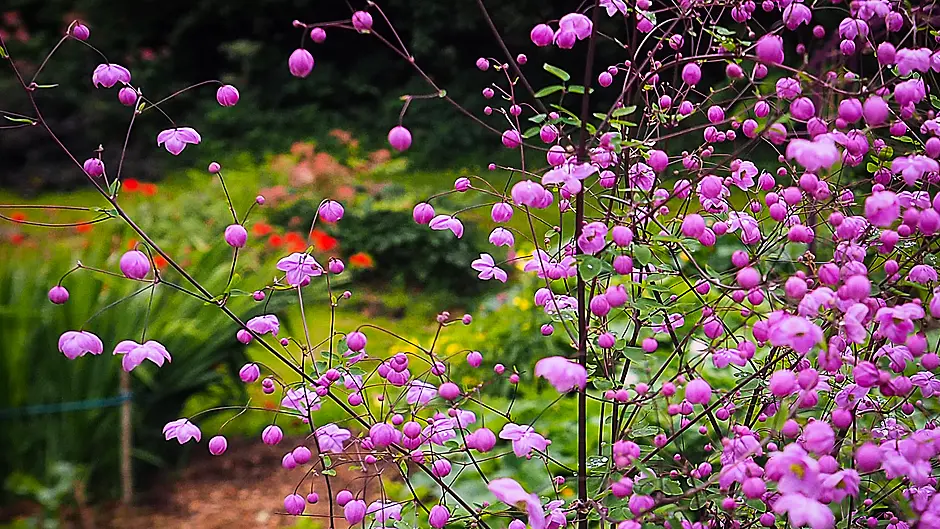THE season starts to turn as we move through August. We aren’t quite in autumn yet but the garden is certainly changing. There are gaps in borders where some flowers are finished and there’s a brownness starting to creep in around some edges.
Moulds and mildews may be leaving their mark too and enthusiasm may wane just a little. Change isn’t a bad thing – you won’t have to mow the lawn as often and there are plenty of new things coming along to replace what is gone – but you do have to embrace the process and not be tempted to give up on garden jobs just as a season turns.
Harvest home
It can seem that this time of year is all about picking, eating and storing what you have grown. Some beds clear as potatoes and onions are lifted. These crops store well so we can eat them through the colder months.
Early peas and broad beans are finished too, although runners and French varieties should still be at peak performance.
Carrots and parsnips are big enough to use and enjoy at their delicious sweet best, but leave large crops a few more weeks before lifting the whole lot to put into store.
Pumpkins should be swelling nicely, but they have a way to go before they are ready to use. Green skin turns orange as most varieties ripen (some stay green, but a look at the seed packet will tell you this) and it’s a good idea to place each fruit on a board or slate so it doesn’t rot where it touches wet earth. Let pumpkins and large squash ripen to a good flavour – they can taste of nothing if you use them too soon.
In the greenhouse
Tomatoes always do well in my polytunnel and I am pleased to have a good crop of ripe fruits. These should keep coming for another few months. Keep an eye out for any mouldy or discoloured leaves and pick these off as soon as you see them. Mould and blight can be a problem in humid conditions – take care not to scatter spores and dispose of diseased leaves with care.
You can strip a lot of diseased foliage and plants will keep ripening fruits. Keep picking as tomatoes ripen – this might be every day at the moment. Make chutneys and sauces or freeze whole fruits to use later for making these delicious treats.
Remember to replant in the greenhouse as soon as any crop is removed. You can still sow cauliflowers, parsley, Swiss chard, spinach, lettuce, rocket and mustard greens for late winter use.
Buy small plants, if you can find them, to put you a few weeks ahead – try spring cabbages for delicious leafy greens next year.
Caterpillar season
Check all your brassicas regularly for signs of caterpillar damage over the next few weeks. You may have found one or two caterpillars before this but now is when the real attack can begin. A lot depends on the weather – if it is lashing rain you will find fewer caterpillars.
If you find holes in leaves or the heart of a plant nibbled out, then turn leaves over and peel back where they wrap around. Caterpillars can do a lot of damage and they hide in any fold.
It’s worth learning the difference between their munching and the damage caused by slugs. Remove what you can and dump them far away from a garden.
You can use nets and covers to keep butterflies away from your brassicas, but make sure there is enough airspace for good ventilation.
I net both doors of my polytunnel – this keeps birds out and also excludes butterflies, unless I forget and leave the net open!
Meadow Rue
I love this plant! It produces a mass of small ball flowers on floating stems that look a little like a cloud of pretty purple insects. They dip and float in any breeze – so pretty that I could watch the performance rather than doing garden tasks.
Meadow Rue comes in different forms. Wild varieties have larger fluffier flowers, ‘Lavender Mist’ has lots of small balls. This plant isn’t hard to grow. It seems to survive in most garden soils. Stems die back in the autumn and grow again in the spring.
Protect against slugs as the stems start growing, until they are around 20cm tall. Plant two or three plants together if you want a good display.
Pesto
Keep picking out the top clusters of leaves on basil plants and make pesto. Two fruit punnets of leaves will make a couple of jars.
Fresh pesto only lasts a week or so in the fridge so I always freeze some in plastic tubs. The flavour and scent of home-made pesto can’t be beaten as an evocation of summer in the winter months.








